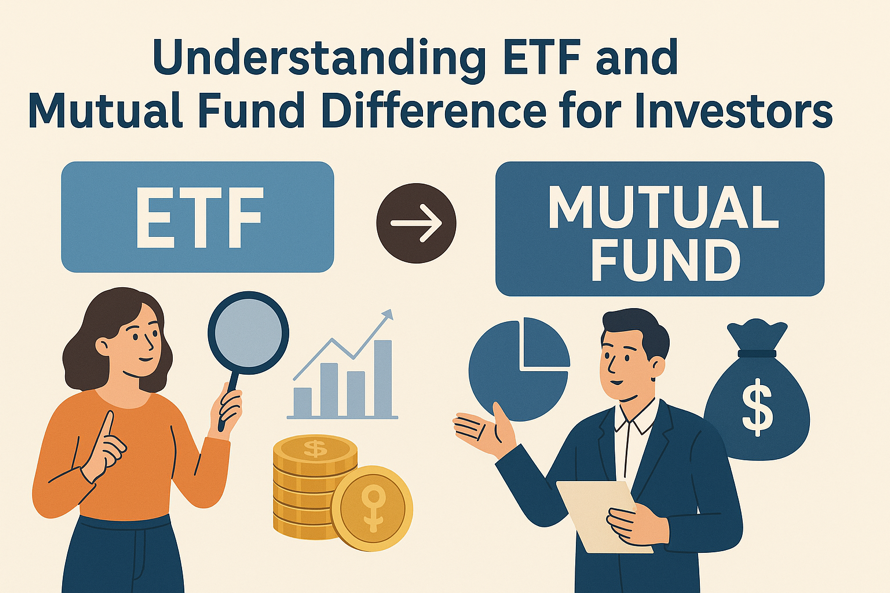SIP Calculator
×
Understanding ETF and mutual fund differences: A guide

Understanding the differences between exchange-traded funds (ETFs) and mutual funds is essential for successful investments in India’s financial market. Both ETFs and mutual funds provide access to a wide range of assets, but they differ greatly in structure, associated fees, tax implications, and approach to handling trades. ETFs allow investors to invest in various assets within any particular industry by tracking the movements of an underlying index.
Mutual funds combine resources from several investors to invest in various assets such as stocks and bonds. Fund managers employ their investments in active or passive management techniques within the structure offered by an investment company. Learn about ETF and mutual fund differences before investing.
Understanding mutual funds
A mutual fund is an investment vehicle in which investors buy shares in a professionally managed group of assets. Mutual fund managers collect contributions from numerous investors and allocate them to diverse assets, including equities, fixed-income investments, and cash. A share in a mutual fund entitles an investor to a portion of the fund’s profits.
• Definition and Basic Principles of Mutual Funds
Mutual funds are designed to collect money from people who wish to invest. The funds are invested in various assets such as shares, debt instruments, and bonds to deliver returns to investors.
Mutual funds allow investors to gain exposure to a wider range of securities than they could manage themselves while providing expert fund management services. By April 2023, the value of assets managed through mutual funds had grown to 41.53 trillion Indian rupees.
“Start investing with confidence! Explore the best
mutual funds
and grow your wealth.”
• How Mutual Funds Work in India
Investing in a mutual fund means putting your money into a scheme run by an AMC. The AMC’s fund managers will add your funds to a large sum of money from other investors to invest in different types of assets. Profits earned from these investments are distributed among the investors based on their initial contribution to the mutual fund.
The Net Asset Value or NAV represents the total value of the securities in which the mutual fund invests. NAV stands for the current market value per unit of a mutual fund. When deciding which investment can meet your needs, evaluate ETF and mutual fund differences.
Exploring exchange-traded funds (ETFs)
ETFs comprise a type of collective investment product that is traded on a stock exchange in the same manner as shares. ETF units are available for purchase and sale on the exchange floor for the entire day. Investors can trade ETFs just like stocks during regular trading hours, taking advantage of possible daily fluctuations.
• What are ETFs?
An exchange-traded fund (ETF) consists of various securities, including stocks and bonds. ETFs enable you to gain exposure to many securities in a single investment, while usually charging lower costs than other funds. You can buy and sell ETFs much more quickly than most other investments. Consider factors such as the level of fees, how easy they are to buy and sell, their compatibility with your current investments, and the overall quality of the underlying assets.
• Benefits of Investing in ETFs in the Indian Market
Exchange-traded funds boast several benefits that appeal to investors of all levels. ETFs give you exposure to many different investments with just a single trade. By diversifying your investments and providing the opportunity to improve returns, exchange-traded funds are an excellent choice for expanding your mutual fund holdings. ETFs in India are bought and sold on the stock exchange all day, just as shares are.
You can buy and sell shares at any time through the day, thanks to real-time pricing, unlike mutual funds, which are only valued once at the end of the trading day. However, before investing, you should analyze the ETF and mutual fund differences.
Comparative analysis: Mutual Funds vs ETFs
Mutual funds and ETFs are both commonly used by investors when trying to build portfolios. Investors turn to them to invest in many assets and build wealth. They are distinct from each other in terms of operations and how people invest in them.
• Key Differences in Structure and Operation
The ways people purchase and sell them are one of the major ETF and mutual fund differences. ETF shares are bought and sold throughout the day through exchanges. You can trade ETFs throughout the trading day. You can buy mutual funds at the close of trading, based on the fund’s NAV.
Mutual funds may have higher fees because their portfolio managers make investment decisions. ETFs tend to save investors money. Some investors pay more capital gains taxes on mutual funds than on ETFs.
• Risk Assessment: Which is Safer?
Investments in both ETFs and mutual funds are exposed to market vagaries. Still, ETFs allow more control as they can be bought and sold within market hours. Active management aims to reduce risks present in a mutual fund.
Closer tracking of index ETFs can prove to be both a convenient and inexpensive investment option. Investing in actively managed mutual funds can shelter your money when the market struggles.
Investment strategies
Smart investment helps increase your financial assets gradually. Selecting the right method is essential to success. You may choose between a mutual fund and an ETF, but deciding which is better for you makes a difference.
• When to Choose Mutual Funds Over ETFs?
Mutual funds could be the right choice for people seeking to expand or build wealth. Those wanting to save for specific goals in the future, such as retirement or a child’s education, may find mutual funds suitable. Mutual funds provide different types of funds focused on debt or hybrid securities investments, tailored for those seeking moderately risky assets.
• Strategic Allocation in ETFs
Every ETF strategy is suited for a different investment objective, with its own level of risk. Invest easily and with lower costs in a wide range of asset classes to form the core of your portfolio. Overcome gaps in a portfolio to expand diversification, reduce benchmark exposure, or increase investment in targeted markets or factors. Mix index ETFs with actively managed funds to achieve diversification and aim for potentially improved returns.
Performance metrics
Both ETFs and mutual funds are highly recommended financial investments. ETFs allow investors to access public-sector companies and high-growth sectors. Their low expense ratios and simple trading mechanisms have increased their appeal. Many long-term investors still prefer mutual funds, as they offer active management and access to a diverse range of assets.
• Historical Performance Comparison in India
ETFs have tended to deliver better returns than several mutual funds when measuring performance over a long period. This is due to the fact that they charge lower expenses and mimic movements of major stock markets. Actively managed mutual funds, on the contrary, might fall behind their benchmarks.
ETFs are less expensive than mutual funds, but mutual funds provide skilled portfolio management. Data over the years indicates ETFs have a stronger track record during periods of rising markets.
• Analyzing Returns: Mutual Funds vs ETFs
Mutual funds tend to deliver capital gains distributions once a year and may distribute dividends throughout the year. ETFs traditionally pay dividends continuously. Still, the manner in which these payments are delivered gives ETF investors the edge. ETFs tend to distribute cash dividends every three months. The size of your payout depends on how many shares you hold.
Tax Implications
One significant difference between ETFs and mutual funds is their tax efficiency. ETFs normally experience fewer tax consequences since they enable shareholders to trade without leading to taxable gains. Mutual funds may incur more capital gains taxes because fund managers continuously buy and sell the underlying securities.
• Understanding Tax on Mutual Funds in India
Dividends from mutual funds have been brought under the traditional tax regime as per the amendments introduced in the Union Budget 2020. Capital gains from mutual funds are charged at different rates based on the investment tenure and the kind of fund. The taxation of capital gains deriving from mutual funds varies based on the holding period.
• Tax Benefits of ETFs
ETFs, whether passive or actively managed, cause shareholders to receive much lower amounts of capital gains relative to mutual funds because of different mechanisms surrounding their creation and trading. Therefore, ETFs generally offer investors lower tax liability than mutual funds.
Liquidity Considerations
ETF and mutual funds differences in liquidity should be considered when deciding which one to invest in. Liquidity refers to how easily you can buy or sell an investment without changing the asset’s price significantly.
• How Liquid are Mutual Funds?
Liquidity in mutual funds describes how quickly and easily investors can buy or sell fund units without influencing the mutual fund’s NAV. A mutual fund’s level of liquidity depends on the kind of fund and what securities it holds. Funds offering higher liquidity, such as liquid or overnight debt funds, are an option for investors looking for quick access to their money.
• Trading ETFs: Market Accessibility
ETFs provide investors with exposure to countries, asset classes, and commodities from around the world. ETFs enable investors to easily invest in previously hard-to-reach markets, such as emerging markets. Mutual funds are usually transacted only once daily, with a price set at the market close.
Conclusion
ETFs can be bought and sold on the stock exchanges daily, but a mutual fund can only be obtained through a fund house, even if it is listed on the exchanges. They are designed in the same manner, with investors able to make trades whenever they like, since there is no lock-in requirement.
A mutual fund usually requires a minimum holding period, so selling before this period may result in charges. Therefore, understanding the basic ETF and mutual fund differences will help you build wealth more efficiently.
FAQs
Q. What is the minimum investment required for mutual funds and ETFs in India?
The minimum investment for mutual funds depends on which mutual fund you choose and what kind of investment you make. Indian regulations set the minimum investment requirement for lump-sum investments at Rs. 100 and for SIPs at Rs. 500.
Q. Can I switch from mutual funds to ETFs?
Yes. A majority of funds that offer ETFs also allow investors to convert their existing mutual fund holdings into ETF shares.
Q. How often should I review my mutual fund or ETF investments?
There is no hard-and-fast guideline for checking fund performance at regular intervals. Checking the performance of long-term investments should be done annually, while for shorter-term investments, it is advisable to monitor it more often.
Q. What are the best platforms to invest in mutual funds and ETFs in India?
Lemonn is one of the leading stockbrokers in India that enables investments in mutual funds.
Disclaimer
The stocks mentioned in this article are not recommendations. Please conduct your own research and due diligence before investing. Investment in securities market are subject to market risks, read all the related documents carefully before investing. Please read the Risk Disclosure documents carefully before investing in Equity Shares, Derivatives, Mutual fund, and/or other instruments traded on the Stock Exchanges. As investments are subject to market risks and price fluctuation risk, there is no assurance or guarantee that the investment objectives shall be achieved. Lemonn (Formerly known as NU Investors Technologies Pvt. Ltd) do not guarantee any assured returns on any investments. Past performance of securities/instruments is not indicative of their future performance.







